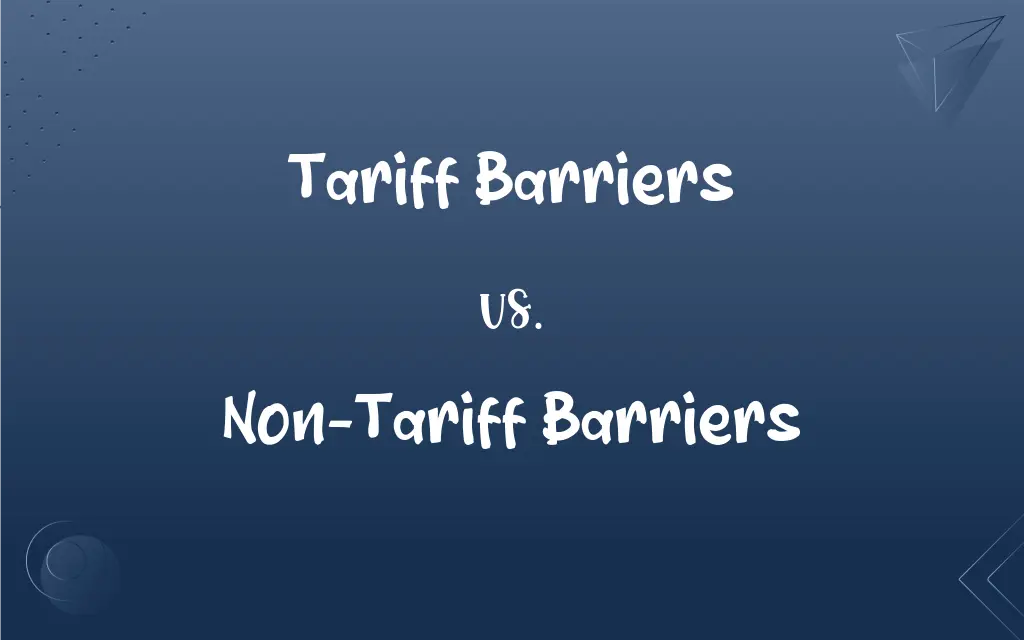Tariff Barriers vs. Non-Tariff Barriers: What's the Difference?
Edited by Aimie Carlson || By Janet White || Published on February 28, 2024
Tariff barriers are taxes imposed on imported goods, while non-tariff barriers are trade restrictions other than tariffs, like quotas and licensing.

Key Differences
Tariff barriers are direct taxes or duties levied on imported goods to make them more expensive and less competitive. Non-tariff barriers, however, encompass a range of trade restrictions like quotas, licensing requirements, and standards that limit imports without imposing taxes.
The primary purpose of tariff barriers is to raise government revenue and protect domestic industries by increasing the cost of imported goods. Non-tariff barriers are often used to protect specific industries, manage trade volumes, or enforce safety and quality standards, influencing trade through means other than cost.
Tariff barriers are implemented through a country's customs authority and are relatively transparent. Non-tariff barriers can be more subtle, involving bureaucratic procedures, regulations, or policies that can be less transparent and harder to quantify.
Tariff barriers directly affect the price of goods, making them potentially less attractive to consumers. Non-tariff barriers can limit the quantity of goods imported or increase the difficulty and cost of meeting import criteria, impacting the flow of trade.
The World Trade Organization (WTO) seeks to reduce tariff barriers, while non-tariff barriers have become more significant in global trade discussions, often being harder to negotiate and resolve.
ADVERTISEMENT
Comparison Chart
Nature
Taxes on imported goods
Trade restrictions other than taxes
Primary Purpose
Generate revenue, protect domestic industries
Protect industries, manage trade, enforce standards
Implementation
Through customs, transparent
Bureaucratic, less transparent
Direct Impact
Affects price of imports
Affects quantity, standards of imports
Global Trade Perspective
Subject to reduction by WTO agreements
Increasingly significant in trade negotiations
ADVERTISEMENT
Tariff Barriers and Non-Tariff Barriers Definitions
Tariff Barriers
Customs duties imposed to regulate the flow of goods across borders.
The new tariff barriers affected the import of electronic goods.
Non-Tariff Barriers
Trade restrictions that are not related to taxation but limit imports.
Non-tariff barriers included quotas on the number of imported vehicles.
Tariff Barriers
Duties levied on imports to generate revenue and protect domestic businesses.
The tariff barriers on agricultural products were aimed at supporting local farmers.
Non-Tariff Barriers
Trade barriers like quotas, licenses, and standards excluding taxes.
Non-tariff barriers such as stringent safety regulations affected the import of toys.
Tariff Barriers
Financial charges applied to imports to make them more expensive.
Tariff barriers were used to increase the price of foreign cars.
Non-Tariff Barriers
Restrictions on trade implemented through means other than tariffs.
Import licensing requirements acted as non-tariff barriers for foreign companies.
Tariff Barriers
Taxes imposed by a government on imported goods.
The government imposed tariff barriers on steel imports to protect the local industry.
Non-Tariff Barriers
Regulatory measures to control imports without imposing duties.
The country enforced non-tariff barriers through strict quality checks on food imports.
Tariff Barriers
Government-imposed taxes on foreign products to create a market advantage for domestic goods.
Tariff barriers were introduced to give an edge to domestically produced textiles.
Non-Tariff Barriers
Measures excluding taxes, used to protect domestic industries and control import volumes.
The government's non-tariff barriers included a cap on the import of certain textiles.
FAQs
Do tariff barriers affect the price of goods?
Yes, they increase the cost of imported goods.
Are tariff barriers subject to international regulation?
Yes, especially through agreements like those of the WTO.
What are tariff barriers?
Tariff barriers are taxes imposed on imported goods.
Why do countries implement tariff barriers?
To protect domestic industries and generate revenue.
What is the purpose of non-tariff barriers?
To control trade volumes, protect industries, and enforce safety/quality standards.
Are tariff barriers transparent?
Yes, they are generally transparent and implemented through customs.
How do consumers feel the impact of tariff barriers?
Consumers may pay higher prices for goods subject to tariffs.
Do tariff barriers impact government revenue?
Yes, they are a source of revenue for governments.
What are non-tariff barriers?
Non-tariff barriers are trade restrictions other than tariffs, like quotas, standards, and licensing.
How do non-tariff barriers impact trade?
They can limit the quantity of imports or impose additional requirements.
How do non-tariff barriers affect international businesses?
They can increase the cost and complexity of entering a foreign market.
Can tariff barriers lead to trade wars?
Yes, as countries may retaliate against each other's tariffs.
Can non-tariff barriers be challenged in the WTO?
Yes, if they are deemed to unfairly restrict trade.
How transparent are non-tariff barriers?
They can be less transparent, involving complex regulations and procedures.
Can tariff barriers protect emerging industries?
Yes, by making imported competitors more expensive.
Is reducing tariff barriers a goal of free trade agreements?
Yes, many free trade agreements aim to reduce or eliminate tariff barriers.
Are non-tariff barriers easy to negotiate in trade deals?
They can be challenging due to their diverse forms and impacts.
Do non-tariff barriers play a role in global trade negotiations?
Yes, they are increasingly significant in trade discussions.
What are examples of non-tariff barriers?
Examples include import quotas, licensing requirements, and safety regulations.
Can non-tariff barriers be used for environmental protection?
Yes, through import restrictions on environmentally harmful products.
About Author
Written by
Janet WhiteJanet White has been an esteemed writer and blogger for Difference Wiki. Holding a Master's degree in Science and Medical Journalism from the prestigious Boston University, she has consistently demonstrated her expertise and passion for her field. When she's not immersed in her work, Janet relishes her time exercising, delving into a good book, and cherishing moments with friends and family.
Edited by
Aimie CarlsonAimie Carlson, holding a master's degree in English literature, is a fervent English language enthusiast. She lends her writing talents to Difference Wiki, a prominent website that specializes in comparisons, offering readers insightful analyses that both captivate and inform.







































































